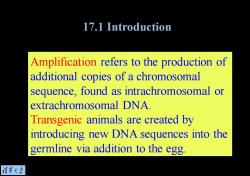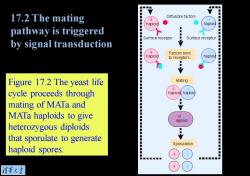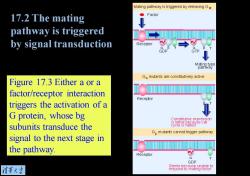清华大学:《分子生物学》课程PPT教学课件(基因ene)第十七章 DNA的重新排列(Rearrangement of DNA)

Chapter 17 Rearrangement of DNA 清革大当
Chapter 17 Rearrangement of DNA

17.1 Introduction 17.2 The mating pathway is triggered by pheromone-receptor interactions 17.3 The mating response activates a G protein 17.4 Yeast can switch silent and active loci for mating type 17.5 The MAT locus codes for regulator proteins 17.6 Silent cassettes at HML and HMR are repressed 17.7 Unidirectional transposition is initiated by the recipient MAT locus 17.8 Regulation of HO expression 17.9 Trypanosomes switch the VSG frequently during infection 17.10 New VSG sequences are generated by gene switching 17.11 VSG genes have an unusual structure 17.12 The bacterial Ti plasmid causes crown gall disease in plants 17.13 T-DNA carries genes required for infection 17.14 Transfer of T-DNA resembles bacterial conjugation 17.15 Selection ofamplified genomic sequences 17.16 Transfection introduces exogenous DNA into cells 17.17 Genes can be injected into animal eggs 17.18 ES cells can be incorporated into embryonic mice 17.19 Gene targeting allows genes to be replaced or knocked out 清菜大当
17.1 Introduction 17.2 The mating pathway is triggered by pheromone-receptor interactions 17.3 The mating response activates a G protein 17.4 Yeast can switch silent and active loci for mating type 17.5 The MAT locus codes for regulator proteins 17.6 Silent cassettes at HML and HMR are repressed 17.7 Unidirectional transposition is initiated by the recipient MAT locus 17.8 Regulation of HO expression 17.9 Trypanosomes switch the VSG frequently during infection 17.10 New VSG sequences are generated by gene switching 17.11 VSG genes have an unusual structure 17.12 The bacterial Ti plasmid causes crown gall disease in plants 17.13 T-DNA carries genes required for infection 17.14 Transfer of T-DNA resembles bacterial conjugation 17.15 Selection of amplified genomic sequences 17.16 Transfection introduces exogenous DNA into cells 17.17 Genes can be injected into animal eggs 17.18 ES cells can be incorporated into embryonic mice 17.19 Gene targeting allows genes to be replaced or knocked out

17.1 Introduction Amplification refers to the production of additional copies of a chromosomal sequence,found as intrachromosomal or extrachromosomal DNA. Transgenic animals are created by introducing new DNA sequences into the germline via addition to the egg. 清苇大兰
Amplification refers to the production of additional copies of a chromosomal sequence, found as intrachromosomal or extrachromosomal DNA. Transgenic animals are created by introducing new DNA sequences into the germline via addition to the egg. 17.1 Introduction

17.1 Introduction Amplification refers to the production of additional copies of a chromosomal sequence,found as intrachromosomal or extrachromosomal DNA. Transgenic animals are created by introducing new DNA sequences into the germline via addition to the egg 情菜大当
Amplification refers to the production of additional copies of a chromosomal sequence, found as intrachromosomal or extrachromosomal DNA. Transgenic animals are created by introducing new DNA sequences into the germline via addition to the egg. 17.1 Introduction

17.2 The mating pathway is triggered by signal transduction MATa MATo MATa/MATo Celltype a 以 alc Mating yes yes no Sporuiation no no ves Pheromone a factor a factor none Re ceptor bind s o factor binds a factor none Figure 17.1 Mating type controls several activities. 清苇大当
Figure 17.1 Mating type controls several activities. 17.2 The mating pathway is triggered by signal transduction

17.2 The mating Diffusible factors haploid haploid pathway is triggered Surface receptor Surface receptor by signal transduction Factors bind haploid to receptors haploid ■ Figure 17.2 The yeast life Mating cycle proceeds through haploid mating of MATa and MATa haploids to give diploid heterozygous diploids ◆ that sporulate to generate Sporulation haploid spores. ■ 情華大当
Figure 17.2 The yeast life cycle proceeds through mating of MATa and MATa haploids to give heterozygous diploids that sporulate to generate haploid spores. 17.2 The mating pathway is triggered by signal transduction

Mating pathway is triggered by releasing G 17.2 The mating Factor pathway is triggered by signal transduction Receptor GTP M盟,xe G mutants are constitutively active Figure 17.3 Either a or a factor/receptor interaction Receptor triggers the activation of a G protein,whose bg subunits transduce the Gmutants cannot trigger pathway signal to the next stage in the pathway. Receptor GDP 清菜大兰 品5品P
Figure 17.3 Either a or a factor/receptor interaction triggers the activation of a G protein, whose bg subunits transduce the signal to the next stage in the pathway. 17.2 The mating pathway is triggered by signal transduction

a-factor or o-factor 17.2 The mating pathway is triggered by STE2=a-factor receptoSCG1 STE4 STE18 S7E3=a-factor recepto GG阝 Gy signal transduction STE20=kinase Figure 17.4 The same mating 业 STE11 =kinase type response is triggered by ↓ interaction of either pheromone STE7 kinase with its receptor.The signal is ↓ transmitted through a series of fus1=kinase needed for cell fusion 品sse kinases to a transcription factor; KSS1 kinase activates conjugation there may be branches to some of the final functions. STE12 transcription factor farl 情菜大当 inhibits CLN2
Figure 17.4 The same mating type response is triggered by interaction of either pheromone with its receptor. The signal is transmitted through a series of kinases to a transcription factor; there may be branches to some of the final functions. 17.2 The mating pathway is triggered by signal transduction

17.2 The mating pathway is triggered by signal transduction Mammal Fly Wom 怡at Extracellular counter-receptor Membrane Tyrosine kinase Sevenless let-23 receptor receptor receptor Mating facor receptor recentor Cyt osolic Grb2 sem-5 com ponents GAP1 STE23GB7 Ras Ras1 et-60 ST E20 ME KK ST E11 c-Raf D-raf let-45 MEK D-sor ST E7 MAP kinase FUS3 KSS1 Nudear STE12 FARI effectors Figure 26.29 Homologous proteins are found in signal transduction cascades in a wide variety of organisms. 清苇大当
Figure 26.29 Homologous proteins are found in signal transduction cascades in a wide variety of organisms. 17.2 The mating pathway is triggered by signal transduction

Silent cassette Active cassette Silent cassette 17.3 Yeast can switch HML MAT HMR silent and active loci for mating type Change of mating type occurs when a cassette replaces a cassette Figure 17.5 Changes of 0 mating type occur when Freque nt silent cassettes replace active 级量■■■量细数数 Change of mating type cassettes of opposite occurs when a cassette replaces ocas sette genotype;when transpositions occur between Rare cassettes of the same type, 如■■■■■ No change of mating the mating type remains type occurs when cassette of same type unaltered. replaces active cassette 清菜大当
Figure 17.5 Changes of mating type occur when silent cassettes replace active cassettes of opposite genotype; when transpositions occur between cassettes of the same type, the mating type remains unaltered. 17.3 Yeast can switch silent and active loci for mating type
按次数下载不扣除下载券;
注册用户24小时内重复下载只扣除一次;
顺序:VIP每日次数-->可用次数-->下载券;
- 清华大学:《分子生物学》课程PPT教学课件(基因ene)第十六章 逆转录病毒和逆转座子(Retroviruses and retroposons).ppt
- 清华大学:《分子生物学》课程PPT教学课件(基因ene)第十五章 转座子(Transposons).ppt
- 清华大学:《分子生物学》课程PPT教学课件(基因ene)第十四章 重组和修复(Recombination and repair).ppt
- 清华大学:《分子生物学》课程PPT教学课件(基因ene)第十三章 DNA复制(DNA replication).ppt
- 清华大学:《分子生物学》课程PPT教学课件(基因ene)第十二章 复制子(The replicon).ppt
- 清华大学:《分子生物学》课程PPT教学课件(基因ene)第十一章 噬菌体的战略(Phage strategies).ppt
- 清华大学:《分子生物学》课程PPT教学课件(基因ene)第十章 操纵子(The operon).ppt
- 清华大学:《分子生物学》课程PPT教学课件(基因ene)第九章 转录(Transcription).ppt
- 清华大学:《分子生物学》课程PPT教学课件(基因ene)第八章 蛋白质定位(Protein localization).ppt
- 清华大学:《分子生物学》课程PPT教学课件(基因ene)第七章 遗传密码的利用(Using the genetic code).ppt
- 清华大学:《分子生物学》课程PPT教学课件(基因ene)第六章 蛋白质合成(Protein synthesis).ppt
- 清华大学:《分子生物学》课程PPT教学课件(基因ene)第五章 信使RNA(Messenger RNA).ppt
- 清华大学:《分子生物学》课程PPT教学课件(基因ene)第四章 簇和重复(Clusters and repeats).ppt
- 清华大学:《分子生物学》课程PPT教学课件(基因ene)第三章 有多少基因(How many genes are there).ppt
- 清华大学:《分子生物学》课程PPT教学课件(基因ene)第二章 从基因到基因组(From Genes to Genomes).ppt
- 清华大学:《分子生物学》课程PPT教学课件(基因ene)第一章 基因是DNA(Genes are DNA).ppt
- 清华大学:《分子生物学》课程PPT教学课件(基因ene)绪论 Molecular Biology(主讲:王钊).ppt
- 河北农业大学:《分子生物学》课程教学资源(PPT课件)第十二章 免疫多样性产生的机制.ppt
- 河北农业大学:《分子生物学》课程教学资源(PPT课件)第十一章 病毒的分子生物学.ppt
- 河北农业大学:《分子生物学》课程教学资源(PPT课件)第十章 遗传重组.ppt
- 清华大学:《分子生物学》课程PPT教学课件(基因ene)第十八章 染色体(Chromosomes).ppt
- 清华大学:《分子生物学》课程PPT教学课件(基因ene)第十九章 核小体(Nucleosomes).ppt
- 清华大学:《分子生物学》课程PPT教学课件(基因ene)第二十章 转录的起始(Initiation of transcription).ppt
- 清华大学:《分子生物学》课程PPT教学课件(基因ene)第二十一章 转录的调控(Regulation of Transcription).ppt
- 清华大学:《分子生物学》课程PPT教学课件(基因ene)第二十二章 核的剪切(Nuclear splicing).ppt
- 清华大学:《分子生物学》课程PPT教学课件(基因ene)第二十三章 催化RNA(Catalytic RNA).ppt
- 清华大学:《分子生物学》课程PPT教学课件(基因ene)第二十四章 免疫多样性(Immune diversity).ppt
- 清华大学:《分子生物学》课程PPT教学课件(基因ene)第二十五章 蛋白质间的开放交通(Protein trafficking).ppt
- 清华大学:《分子生物学》课程PPT教学课件(基因ene)第二十六章 信号的传输(Signal transduction).ppt
- 清华大学:《分子生物学》课程PPT教学课件(基因ene)第二十七章 细胞循环和生长调控(Cell cycle and growth regulation).ppt
- 清华大学:《分子生物学》课程PPT教学课件(基因ene)第二十八章 致癌基因和癌症(Oncogenes and cancer).ppt
- 清华大学:《分子生物学》课程PPT教学课件(基因ene)第二十九章 梯度、级联和发信号的途径(Gradients, cascades, and signaling pathways).ppt
- 四川大学:《植物生物学》课程教学资源(教案讲义)第一章 植物的细胞和组织.pdf
- 四川大学:《植物生物学》课程教学资源(教案讲义)第二章 植物体的形态结构和发育.pdf
- 四川大学:《植物生物学》课程教学资源(教案讲义)第三章 植物的无机营养.pdf
- 四川大学:《植物生物学》课程教学资源(教案讲义)第四章 光合作用.pdf
- 四川大学:《植物生物学》课程教学资源(教案讲义)第五章 植物的繁殖.pdf
- 四川大学:《植物生物学》课程教学资源(教案讲义)第六章 植物的生长发育及其调控.pdf
- 四川大学:《植物生物学》课程教学资源(教案讲义)第七章 生物多样性和植物的分类及命名.pdf
- 四川大学:《植物生物学》课程教学资源(教案讲义)第八章 藻类植物.pdf
